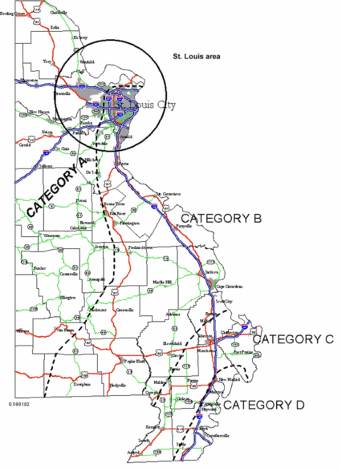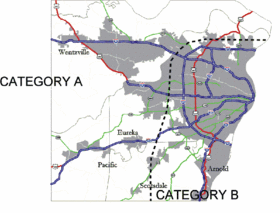Difference between revisions of "Category:756 Seismic Design"
m (Per Bridge, updated Bridge seismic design process flowchart) |
m (Per BR, revised the Bridge seismic design process flowchart.) |
||
| Line 1: | Line 1: | ||
{|style="padding: 0.3em; margin-left:15px; border:2px solid #a9a9a9; text-align:center; font-size: 95%; background:#f5f5f5" width="160px" align="right" | {|style="padding: 0.3em; margin-left:15px; border:2px solid #a9a9a9; text-align:center; font-size: 95%; background:#f5f5f5" width="160px" align="right" | ||
|- | |- | ||
| − | |[ | + | |[http://sharepoint/sites/de/epg/Lists/EPGResponse/Attachments/534/16-020-DSC%20SeismicRetrofitFlow_LFD.pdf Bridge Seismic Design Process Flowchart] |
|} | |} | ||
| − | All new bridges on the state system shall include some level of seismic design and/or detailing to resist earthquakes | + | All new bridges on the state system shall include some level of seismic design and/or detailing to resist earthquakes per the [http://sharepoint/sites/de/epg/Lists/EPGResponse/Attachments/534/16-020-DSC%20SeismicRetrofitFlow_LFD.pdf Bridge Seismic Design Process Flowchart] and an expected seismic event for a given return period. For example, for a multi span bridge in Seismic Performance Categories B, C or D, both design and detailing work is needed or detailing work only needed shall be determined as per “Bridge Seismic Design Process Flow chart”. |
{| style="margin: 1em auto 1em auto" align="left" | {| style="margin: 1em auto 1em auto" align="left" | ||
|- | |- | ||
| − | |[[Image:756 Figure Seismic Performance Categories.gif| | + | |[[Image:756 Figure Seismic Performance Categories.gif|340px|left|thumb|<center>'''Seismic Performance Categories'''<br/>The entire state of Missouri outside of<br/>Categories B, C and D is Category A.</center>]]||width="5"| ||[[Image:756 Figure St. Louis Area.gif|280px|left|thumb|<center>'''St. Louis Area'''</center>]]||width="5"| |
|} | |} | ||
| Line 13: | Line 13: | ||
| | ||
| − | When existing bridges | + | When existing bridges are identified as needing repairs or maintenance, a decision on whether to include seismic retrofitting in the scope of the project shall be determined per the “Bridge Seismic Design Process Flowchart”, the extent of the rehabilitation work and the expected life of the bridge after the work. For example, if the bridge needs painting or deck patching, no retrofitting is recommended. However, redecking or widening the bridge indicates that MoDOT is planning to keep the bridge in the state system with an expected life of at least 30 more years. In these instances, the project core team should consider cost effective methods of retrofitting the existing bridge. |
{|style="padding: 0.3em; margin-left:15px; border:1px solid #a9a9a9; text-align:center; font-size: 95%; background:#ffddcc" width="210px" align="right" | {|style="padding: 0.3em; margin-left:15px; border:1px solid #a9a9a9; text-align:center; font-size: 95%; background:#ffddcc" width="210px" align="right" | ||
|- | |- | ||
Revision as of 11:54, 4 January 2017
| Bridge Seismic Design Process Flowchart |
All new bridges on the state system shall include some level of seismic design and/or detailing to resist earthquakes per the Bridge Seismic Design Process Flowchart and an expected seismic event for a given return period. For example, for a multi span bridge in Seismic Performance Categories B, C or D, both design and detailing work is needed or detailing work only needed shall be determined as per “Bridge Seismic Design Process Flow chart”.
When existing bridges are identified as needing repairs or maintenance, a decision on whether to include seismic retrofitting in the scope of the project shall be determined per the “Bridge Seismic Design Process Flowchart”, the extent of the rehabilitation work and the expected life of the bridge after the work. For example, if the bridge needs painting or deck patching, no retrofitting is recommended. However, redecking or widening the bridge indicates that MoDOT is planning to keep the bridge in the state system with an expected life of at least 30 more years. In these instances, the project core team should consider cost effective methods of retrofitting the existing bridge.
| Bridge Dampers, Seismic |
| Report 2005 |
| Summary 2005 |
| Bridge, Cable-Stayed, Seismic |
| Report 2007 |
| Earthquake Hazard Assessment |
| Report 2001 |
| Summary 2001 |
| See also: Innovation Library |

